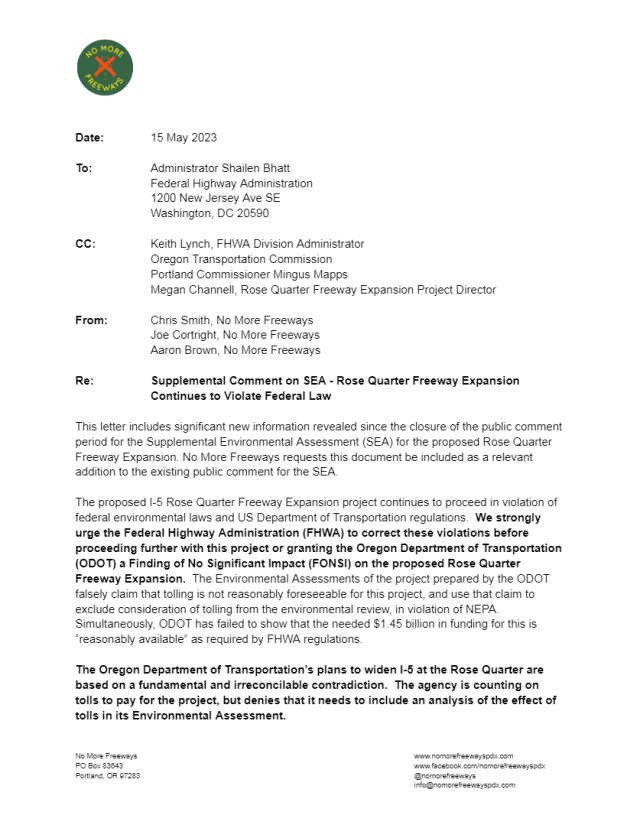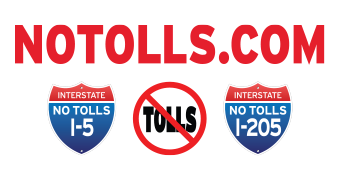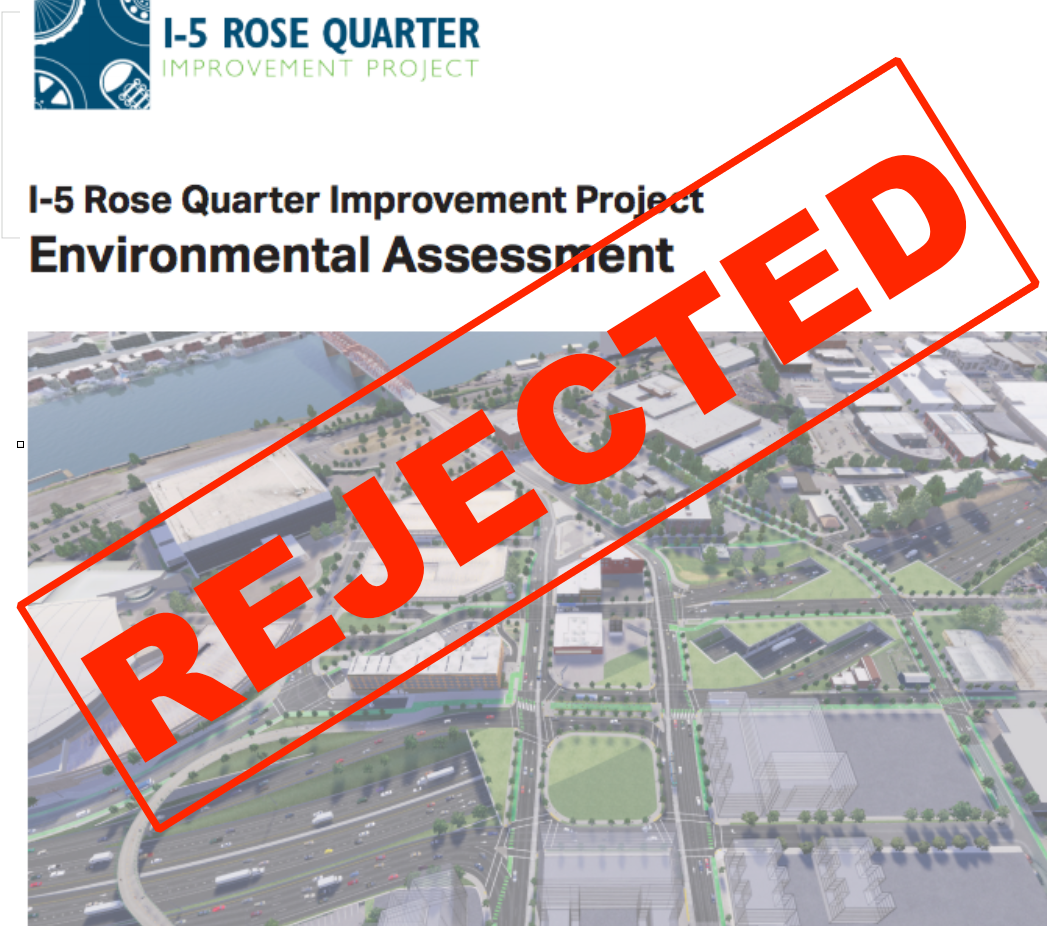The Oregon Department of Transportation maintains that it will use tolls to pay for the I-5 Rose Quarter Freeway widening project, but that it doesn’t need to evaluate tolling as part of the project’s environmental assessment because tolling isn’t “reasonably foreseeable.”
- Tolls can’t be both “available” and “not reasonably foreseeable.
- Tolling would eliminate the need to widen the I-5 freeway.
- Without tolls, ODOT can’t pay for the $1.45 billion Rose Quarter project.
- FHWA can’t approve the Rose Quarter project because of these errors and contradictions.
Federal law and regulations require two things for major highway projects: a determination that funding is “reasonably available” before they can move forward, and also an evaluation of conditions and alternatives that are “reasonably foreseeable.”
The official position of the Oregon Department of Transportation is that tolling is not a reasonably foreseeable policy for I-5 Rose Quarter project, but that tolls are, at the same time, a “reasonably available” source of funding for the $1.45 billion project.
ODOT wants to count future tolls—which were recently put on hold by Governor Tina Kotek—as a source of revenue to prove to the Federal Highway Administration that funding meets the requirement that funding be shown to be reasonably available. And at exactly the same time, the agency continues to assert in its Environmental Assessment, prepared to comply with the National Environmental Policy Act, that tolling of I-5 doesn’t need to be studied in the EA, because its simply not “reasonably foreseeable.”
Tolls can’t be both “available” and not “foreseeable”
ODOT’s contradiction on whether tolling is part of the I-5 Rose Quarter project is a classic dilemma: Tolls are either available and foreseeable, or they aren’t. Either way, the I-5 Rose Quarter project is in deep trouble.
If tolls are “reasonably available,” then ODOT needs to re-do its Environmental Assessment to include the effect of tolling—and it should almost certainly perform a full Environmental Impact Statement, rather than continuing to assert that the project has “No Significant Impact”
If tolls aren’t “reasonably foreseeable” then ODOT doesn’t have a source of funds to pay for the project, and according to its own regulations, the Federal Highway Administration can’t allow the project to move forward.
Tolling would eliminate the need to widen the Rose Quarter
For years, ODOT has maintained it doesn’t need to include a study of tolling in its I-5 Environmental Analysis, based on specious claims that it couldn’t anticipate tolling—even after the 2017 Legislature enacted tolling into law and directed and authorized ODOT to implement tolling on I-5 and I-205 in the Portland area. And even after ODOT itself applied to the Federal Highway Administration to toll I-5 and I-205 in 2018. Both the 2019 Environmental Assessment and the 2022 Supplemental Environmental Assessment continue to claim that tolling isn’t “reasonably available.”
So why would ODOT not include tolling in its environmental analysis? The reason is straightforward: a tolled I-5 would have so much less traffic that there would no longer be any case for spending $1.45 billion to widen the roadway. As we’ve documented at City Observatory, ODOT has hidden its plans to build a 160-foot wide roadway, enough for a 10 lane freeway. That wider freeway–and not congestion reduction–is its real priority.
If the Environmental Assessment included the effect of tolling on traffic in the Rose Quarter area, it would show that the project is vastly oversized, and that all of the project’s congestion reduction benefits could be achieved without widening the freeway.
In fact, an ODOT consultant’s study shows that congestion pricing would be more effective in reducing congestion, and do so at a lower cost. A July 2022 memorandum attached to the Rose Quarter Supplemental Environmental Assessment shows that road pricing would reduce traffic volumes and increase freeway speeds more than spending $1.45 billion to widen the freeway.
Without tolling ODOT can’t pay for the Rose Quarter
It’s been apparent for years that ODOT simply can’t afford to pay for the Rose Quarter without tolls. The 2017 Legislature earmarked about $450 million to pay for the project, but since then, the project’s cost has tripled to $1.45 billion, and the 2021 Legislature authorized ODOT to use the money for other projects, and ODOT has diverted nearly all of those funds to pay for construction of the I-205 Abernethy Bridge. In April 2022, Oregon Transportation Commission Chair Bob Van Brocklin soberly warned:
“I think it comes down kind of to this simple conclusion which is if we don’t have tolling I don’t see an alternative funding mechanism to do any of these.I don’t think we have the resources to build the Abernethy Bridge, the Rose Quarter project or the Interstate Bridge without tolling.” (Emphasis added)
The plight of the Rose Quarter project was underscored at the May 11, 2023 meeting of the Oregon Transportation Commission, when ODOT staff admitted they couldn’t meet a long-delayed June, 2023 deadline to come up with a financial plan for the Rose Quarter. The OTC voted to give them another year to develop the plan. Commissioner Lee Beyer (who had been chair of the Legislative committee that provided initial funding for the project in 2017) observed:
“I have to say that given what we all know about our financial picture at this point, I’m not sure how we finance this project. I think it’s going to require some additional legislative action and commitment that we’re going to move forward on this… It’s a challenge financially. And so that’ll be something that I want to make sure from a fiduciary standpoint that we limit our financial exposure while still supporting the project until those finance decisions are made. (Emphasis added)
In short, ODOT simply has no plan to pay for the Rose Quarter project, and without tolling, there’s no way funding could even be considered to be “reasonably available.”
Federal Highway Administration can’t move forward with this project
As a legal matter, ODOT’s contradictory positions on tolls mean that the Federal Highway Administration cannot legally move forward with this project. In order to proceed, FHWA would have to make a legal determination that funding is “reasonably available”—something that is plainly not true, as evidenced by the lack of any financial plan for the project, and the statements of OTC members. At the same time, the Rose Quarter project’s Environmental Assessment (last updated 12 months ago)—steadfastly maintains that tolling is not “reasonably foreseeable” and is not reflected in the project’s environmental analysis.
What this means is that FHWA needs to send ODOT back to the drawing board for the Rose Quarter. ODOT needs to do a new environmental assessment—and should undertake a full Environmental Impact Statement—that explicitly includes tolling as an alternative to expensive freeway widening. And ODOT needs to produce a real financial plan that shows where the $1.45 billion price tag of this project will come from.
A fuller description of the legal requirements and factual basis of the Rose Quarter project are contained in No More Freeways May 15, 2023 letter to Federal Highway Administrator Shailen Bhatt.




